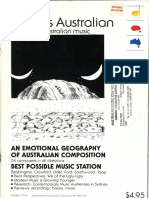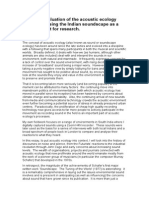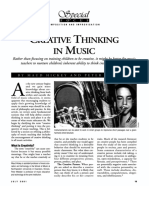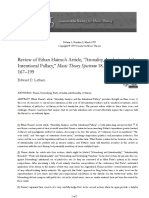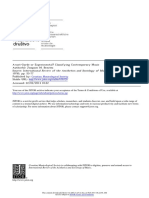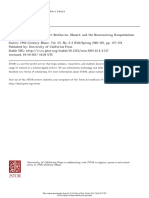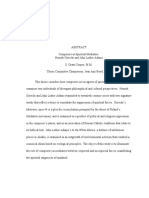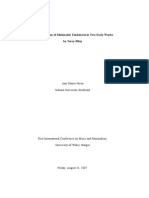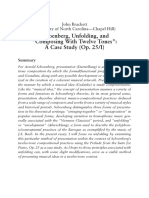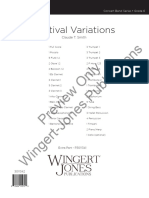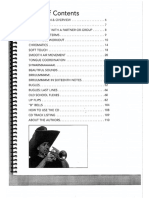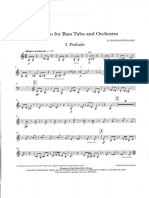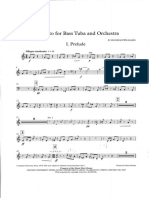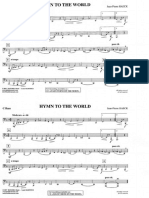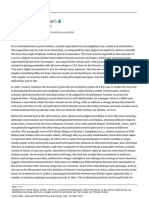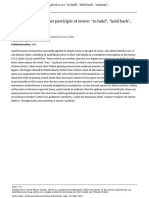Expression
Expression
Uploaded by
張顥嚴Copyright:
Available Formats
Expression
Expression
Uploaded by
張顥嚴Copyright
Available Formats
Share this document
Did you find this document useful?
Is this content inappropriate?
Copyright:
Available Formats
Expression
Expression
Uploaded by
張顥嚴Copyright:
Available Formats
Expression
Expression
Nancy Kovaleff Baker, Max Paddison and Roger Scruton
https://doi.org/10.1093/gmo/9781561592630.article.09138
Published in print: 20 January 2001
Published online: 2001
In its simplest sense, the term ‘expression’ is applied to those elements of a musical performance that
depend on personal response and that vary between different interpretations. In this sense a piano teacher
may enjoin a pupil to ‘put in the expression’, i.e. to play a piece with a certain articulation, tempo and
phrasing. It is not clear how this use of the term relates to the concept that occurs in music criticism (as
when a piece of music is said to express some emotion, outlook or idea). What does it mean to say of a piece
of music that it has expression, or that it expresses, or is expressive of a certain state of mind? The
question is a philosophical one, and reflects the profound uncertainty in contemporary aesthetics over the
most important concept bequeathed to it by the Romantic movement.
For expression marks, see Tempo and expression marks.
I. History of the concept of expression
1. Before 1800.
Nancy Kovaleff Baker
The Aristotelian doctrine of art as imitation of nature was fundamental to both artistic creation and
evaluation until the late 18th century. Although the objects of imitation and its exactitude varied with the
artistic media and different periods, the mimetic view of art long maintained a position as aesthetic
dogma. Its modification and subsequent rejection for an expressive theory of art were caused by changes in
ideas concerning both the relationship of nature to art and the nature of art itself.
Elaborating on the mimetic theory, the doctrine of the Affections related music to rhetoric in both its
means and its end (see Rhetoric and music, §I, 4, and Affects, theory of the). It was thought that music
could imitate both animate and inanimate nature, the inflections of speech, and the emotions. This
imitation was accomplished by rhetorical method, and its aim was to arouse the listener. Such ideas are
found in the Réflexions critiques sur la poésie et sur la peinture (1719) of Jean Dubos (1670–1742). He regarded
art as a means of arousing moderate passions in men through imitation and thereby keeping them from
boredom. In music, this could be accomplished by either a literal imitation of nature, such as tone-
painting, or a higher type reflecting man’s inner nature, his passions. For the latter ‘one must … know how
to copy nature without seeing it’.
Page 1 of 21
Printed from Grove Music Online. Grove is a registered trademark. Under the terms of the licence agreement, an
individual user may print out a single article for personal use (for details see Privacy Policy).
Subscriber: National Taiwan Normal University; date: 03 May 2022
Expression
In Dubos’ theory, imitation was merely a means to an end; a few decades later, however, Charles Batteux
(1713–80) declared it to be the very purpose of art. In his Les beaux-arts réduits à un même principe (1746),
he asserted that the one principle common to the arts, and indeed their goal, was the imitation of nature.
Relying heavily on Aristotle, Batteux advocated copying not mere reality but rather ‘la belle nature’, a
composite of perfections which enabled one to see the ideal behind nature.
For the next few decades, Batteux’s system was virtually unchallenged as the basis for French aesthetics.
In England, however, some dissenting voices were heard. Charles Avison in his Essay on Musical Expression
(1752) saw the perfection of a composition as arising from melody, harmony and expression, which, when
combined, had ‘the Power of exciting all the most agreeable Passions of the Soul’. Imitation was no longer
seen as the goal of music. Indeed, in his essay On Poetry and Music, as they Affect the Mind (1776), James
Beattie (1735–1803) declared that with no disrespect to Aristotle nor to music, he ‘would strike it off the
list of imitative arts’. The pleasure derived from music resulted not from its resemblance to nature, but
from its power to affect the listener. Thus ‘if we compare Imitation with Expression, the superiority of the
latter will be evident’.
William Jones (1746–94) made the definitive distinction at the conclusion of his ‘Essay on the Arts,
Commonly Called Imitative’ (1772) (The Works of Sir William Jones, viii, 1807): ‘it will appear, that the finest
parts of poetry, musick, and painting, are expressive of the passions, and operate on our minds by
sympathy; that the inferior parts of them are descriptive of natural objects, and affect us chiefly by
substitution’. Expression of the passions was now the most worthwhile aspect of art, while imitation was
but a lower, technical skill. While Dubos believed that music could imitate the passions – that is, create in
sound something resembling them – Jones credited music only with being expressive of the passions.
There was intimated here a new function for the artist: no longer did he merely select from reality, seen or
unseen; he now put into his work an element of interpretation. It was but a short step from such
‘interpretation’ to romantic subjectivity.
In France, the imitative view of art persisted, but its deficiencies came to be acknowledged. In his essay ‘De
l’expression en musique’ (Mercure de France, 1771; written 1759), Abbé André Morellet (1727–1819)
outlined an aesthetic philosophy directly descended from that of Batteux. Yet there was a recognition of
the limitations of imitation, at least with regard to music. While acknowledging weaknesses in the mimetic
theory, Morellet could not bring himself to abandon it. His observations, however, served as the catalyst to
just such a renunciation.
Michel de Chabanon treated the problem of imitation most thoroughly in his De la musique considérée en
elle-même et dans ses rapports avec la parole, les langues, la poésie et le théâtre (1785). He believed it was a
fallacy that the arts, born of nature, devoted all their powers to ‘retracing her immortal image’. He
concluded that music ‘does not imitate, and does not attempt to imitate’. When music did seek to imitate,
it was unconvincing even in ‘reproducing’ the sounds of nature, such as birdsong. Unlike the natural
model, the imitation was bound by both the laws of its art and the limitations of its medium. Imitations of
outer reality were unsatisfactory because sounds, which were directed to the ear, had to detour by way of
the mind and its concepts. In addition, the musical devices used for imitation were so unspecific that they
could be used for a variety of interpretations, all equally valid. It was the unavoidable deviation from reality
that was central to Chabanon’s argument. Attempts at imitation of inner reality, the emotions, were
Page 2 of 21
Printed from Grove Music Online. Grove is a registered trademark. Under the terms of the licence agreement, an
individual user may print out a single article for personal use (for details see Privacy Policy).
Subscriber: National Taiwan Normal University; date: 03 May 2022
Expression
according to Chabanon equally futile. In denying that music was a language of the emotions, he rejected an
entire philosophy based on the alliance of music and rhetoric. He believed that music was neither a
derivative nor an imitation of speech, but a language in itself, independent of all others.
Despite its independence of signification, however, music could affect the emotions. This phenomenon
Chabanon explained by a very subtle and original theory of analogy:
The melody which we shall call tender perhaps does not really place us in the same condition of body and of
spirit in which we would be in actually feeling tenderly for a woman, a father, or a friend. But between
these two conditions, the one actual, the other musical … the analogy is such, that the mind agrees to take
the one for the other.
In the philosophies of Dubos and Batteux, the artistic imitation of passion aroused in the listener diluted
versions of the same emotion. Jones, who did not subscribe to the mimetic theory, believed that the arts
affected us by means of sympathy. The listener’s reaction was here a ‘feeling with’ and would seem to
imply an element of volition; this was response rather than mere reaction, and the emotion need not be
weaker than the artistic stimulus. Nevertheless, as in the earlier theories, the feeling of the listener was the
same as that portrayed by the music; in a sense, the imitative process was merely relocated in the psyche of
the listener.
Chabanon’s explanation by analogy, however, broke with even this vestige of imitation. The sensations of
sound created aesthetic feelings in the listener, and these he could compare to emotional feelings. But,
first, they had no relationship in terms of cause and effect; second, they were different in nature, the one
aesthetic, the other affective; and third, they were separate from each other. The relationship was that of
an analogy and nothing more.
The aesthetic feeling was a sensation more vague and comprehensive than specific sentiments. This was,
in a way, a theory of meta-feelings, for to each aesthetic sensation could be joined many different
particular emotions. Illustrating this versatility of music, Chabanon cited the duo from Grétry’s opera
Silvain (1770), in which the same melody served texts of widely differing character. Thus the aesthetic
sensation, conveying a general idea, was a kind of synthesis that could represent emotional contraries. The
content of music was no longer an imitative interpretation of reality, but transcended it and was itself
capable of many different interpretations. With this view, the relationship between art and the world was,
in a way, inverted; the realm of art was now infinite in its possibilities compared with the limited world of
appearances which it formerly had endeavoured to imitate. Chabanon’s conception of music as
independent of all signification and imitation was basic to much subsequent thought. Ideas such as his led
to the idealistic view of music that developed in the 19th century.
The economist Adam Smith (1723–90) concerned himself not only with the wealth of nations but also with
the problem of mimesis. In an essay entitled ‘Of the Nature of that Imitation which Takes Place in What are
Called the Imitative Arts’ (Essays on Philosophical Subjects, 1795), he expressed ideas often strikingly
parallel to those of Chabanon, although the theory of analogy was missing. He believed that ‘whatever we
feel from instrumental Music is an original, and not a sympathetic feeling: it is our own gaiety, sedateness,
or melancholy: not the reflected disposition of another person’.
Page 3 of 21
Printed from Grove Music Online. Grove is a registered trademark. Under the terms of the licence agreement, an
individual user may print out a single article for personal use (for details see Privacy Policy).
Subscriber: National Taiwan Normal University; date: 03 May 2022
Expression
2. After 1800.
Max Paddison
A fundamental change in the status of music in relation to the other arts occurred in the years around 1800,
the emergence of a new concept of musical expression coinciding with the rise of autonomous
instrumental music as a serious art form. Whereas as late as 1790 instrumental music was considered by
Kant (Kritik der Urteilskraft) as a mere divertissement of no serious importance, it now came to be regarded
as the most elevated of the arts, capable of expressing feelings and ideas beyond the limits of rational
knowledge. Music's new status thus constituted a complete inversion of its lowly ranking among the arts
during the Enlightenment period. What had previously been seen as a disadvantage – that music without
words could not convey definite meanings – now came to be perceived as its greatest advantage over all
other forms of art.
W.H. Wackenroder, in his Phantasien über die Kunst, für Freunde der Kunst (1799), played a key role in the
shaping of this new sensibility, asserting in these highly romantic and fragmented texts that musical
material itself is endowed with mysterious expressive potential, and that ‘between the individual,
mathematical tonal relationships and the individual fibres of the human heart an inexplicable sympathy
has revealed itself, through which the musical art has become a comprehensive and flexible mechanism for
the portrayal of human emotions’. This enthusiasm for heightened emotional states, which used music as
the vehicle for rapture, as an art expressive of infinite and insatiable longing and indefinable feelings
leading to ecstatic mystical revelation, is seen in the writings of numerous artists, poets, composers and
critics of the period, notably in Herder's Kalligone (1800), in E.T.A. Hoffmann's novels, stories and music
criticism, in the music journalism of Weber, Berlioz and Schumann, and in the novels of Jean Paul. Music
was elevated to an art-religion, and was seen as the ultimate language of the emotions.
Among the most notable German Idealist philosophers of the period who attempted to incorporate the
concept of musical expression into a large systematic philosophy are F(riedrich) W(ilhelm) J(oseph von)
Schelling, Georg Wilhelm Friedrich Hegel and Arthur Schopenhauer. Hegel, in Vorlesungen über die Ästhetik
(1835, from his lecture courses given between 1820 and 1826), regarded music as an aspect of the self-
realization of Geist (‘spirit’, ‘mind’), and, because of its intimate relation to ‘inwardness’ (Innerlichkeit), as
the expression of the whole range of emotions that surround the soul. But at the same time, Hegel favoured
vocal music and, like Kant, remained sceptical about instrumental music, seeing a certain futility in its
retreat into ‘sounding inwardness’. Schopenhauer, perhaps the most important and influential figure in
the mid-19th century aesthetics of expression, took a very different position. In Die Welt als Wille und
Vorstellung (1818) he argued that music is the most direct representation or expression of the Will, and is
the art form most immediately capable of conveying this revelatory power and of freeing us from the force
of the Will. His influence, particularly through the second edition (1844) of Die Welt als Wille und
Vorstellung, was decisive for Richard Wagner, and is found both in Wagner's music dramas (most notably
Tristan und Isolde) and in many of his theoretical writings on music, in particular the essay Beethoven
(1870). Wagner's writings of the period 1849–51 (i.e. before his discovery of Schopenhauer in 1854) are
themselves important landmarks in the aesthetics of expression – for example, in their anchoring of
music's expressivity and articulation to the physical and gestural dimension of the drama itself in ways
that are distinctly positivistic in character. In the later writings, however, the influence of Schopenhauer
Page 4 of 21
Printed from Grove Music Online. Grove is a registered trademark. Under the terms of the licence agreement, an
individual user may print out a single article for personal use (for details see Privacy Policy).
Subscriber: National Taiwan Normal University; date: 03 May 2022
Expression
clearly predominates, notably in Wagner's statement that ‘music does not present ideas taken from
everyday phenomena, but is rather itself a comprehensive idea of the world, automatically including
drama’. The position of Friedrich Nietzsche relates both to Schopenhauer and to Wagner. In Die Geburt der
Tragödie aus dem Geiste der Musik (1872), Nietzsche argued that the ecstatic, ‘Dionysian’ aspect of music is
held in balance by the ordering, structuring, reflective ‘Apollonian’ aspect, and that the expressive power
of music, and thereby its value, emerges from the tension between these two extremes. The paradigm for
this theory of expression was, of course, Wagner's music.
There is a sense in which the theories of expression of Schopenhauer and Wagner, and to an extent of
Nietzsche, come full circle, so turning into a version of the theory of imitation. But what is being imitated
or represented now is not the outer world of nature. Instead it is inner nature, the force of the Will itself
which, through this transfiguring power of music, gives immediate access to the world of Ideas behind the
world of appearance, in a distinctly Platonic sense, but also in the sense of a form of ‘cognition without
concepts’. This extreme version of the theory of expression as mimesis of the inner world of feelings also
tips over into what is sometimes mistakenly regarded as its opposite, formalism. Eduard Hanslick offered a
critique of the theory of expression in music that itself led to a position in some ways reminiscent of that of
Batteux in the 18th century, in that the form of the work ‘expresses’ nothing but itself. In Vom Musikalisch-
Schönen (1854), Hanslick set out to refute the expression theory of music, arguing that music traces the
dynamic motion of a feeling, and that this is not the same as expressing an indefinite emotion, for to
represent an indefinite emotion is a contradiction in terms. The first problem of music, therefore, is to give
form to such dynamic motion. Thus he concluded that music expresses neither definite nor indefinite
emotions; if it expresses anything it is the shaping of the musical idea, in purely musical terms. Because
this is a dynamic process, it appears also to evoke the dynamic character of the emotions.
The influence, direct and indirect, of Schopenhauer's and Hanslick's theories in the later 19th and early
20th centuries was profound. It is seen in cross-fertilizations across the arts at the end of the 19th century.
Symbolism can be understood as an exteme refinement either of the expression aesthetic or of the
formalist, autonomy aesthetic, but is probably closest to Hanslick's notion of music as the dynamic
shaping of processes that are analogous to the shifting experience and elusive character of the emotions.
Yet at the same time Symbolism in the literary and visual arts and its equivalent in music, Impressionism,
owe much to Schopenhauer's influence, particularly as filtered through Wagner. Early 20th-century
Expressionism can be seen as the expression aesthetic taken to its ultimate extreme. But here too there is a
paradoxical interaction of apparent opposites. On the one hand, Expressionism is the end point of
Schopenhauer's notion of music as the direct expression of the Will, by way of the powerful influence of
the Freudian concept of the unconscious (itself influenced by Freud's reading of Schopenhauer).
‘Expression’ in Expressionism is no longer the stylized representation of the emotions, or even the idea of
the expression of the individual composer's emotions; instead, it is regarded as the direct expression of the
overwhelming power of the unconscious. On the other hand, Expressionism itself was the extreme
expression of Innerlichkeit, the withdrawal into the self (albeit a self in the process of disintegration). This
withdrawal also indicated a move towards extreme abstraction and non-representation, and to this extent
the influence of Hanslick can still be sensed.
Page 5 of 21
Printed from Grove Music Online. Grove is a registered trademark. Under the terms of the licence agreement, an
individual user may print out a single article for personal use (for details see Privacy Policy).
Subscriber: National Taiwan Normal University; date: 03 May 2022
Expression
Following the explosive culmination of the expression aesthetic in the Expressionist movement, the 20th
century was largely dominated by an anti-expression aesthetic, epitomized in Stravinsky's aggressive
rejection of Wagner (Poétique musicale, 1942) and in the Darmstadt School composers' rejection of the
Expressionist residues in the music of Schoenberg and the Second Viennese School. The notion that music
is about the expression of emotions nevertheless retains a powerful hold on the music-loving public, and
the concept continues to provide a focal point for musical and philosophical aesthetics. The writings of
Meyer, Cooke and Adorno represent three very different ways in which the theory of expression continued
to be addressed in the second half of the 20th century. Each of these theories is also a theory of musical
meaning and of music's similarity to language.
In Emotion and Meaning in Music (1956) Meyer set out a psychological theory of expression based on the
idea of degrees of tonal tension and release, proposing that expression is the result of ‘disturbances in the
goal-oriented tendencies of a musical impulse’ within a world of stylistic and syntactical probability.
Meyer's theory also addressed the relation of uncertainty, instability and incompleteness to notions of
teleology, syntactical probability and the expectation or anticipation of completion, of gaps being filled.
Thus, as well as offering a theory of expression, Meyer in effect also put forward a theory of form. Cooke,
in The Language of Music (1959), made an appealing if somewhat naive argument that it is possible to
construct a lexicon of the expressive gestures of music's vocabulary. He itemized the range of ‘elements of
musical expression’ as a system of tonal tensions, emphasizing that these can be understood both
melodically and harmonically. For example, the ascending pattern 5–1–(2)–3 with a major 3rd stresses
‘joy pure and simple by aiming at the major third’, whereas the same pattern with a minor 3rd ‘expresses
pure tragedy by aiming at the minor third’. He argued that such musical gestures are valid for all time,
outside any historical or social context, and claimed a natural correspondence between musical ‘figures’
and feeling. In a sense, therefore, Cooke's theory of musical expression is also a mimetic theory. Adorno, in
contrast, firmly contextualized the concept of expression, and proposed that the inscrutable character of
autonomous musical works is the result of the contradiction between the logicality and rationality of
musical structures and the apparent irrationality of expression. Adorno's position clearly owes something
to Hanslick as well as to Hegel. He argued in Ästhetische Theorie (1970) that the previously mimetic,
gestural and magical aspects of art are retained residually in the material of the work of art, but are now
integrated into the work's ‘law of form’ through the powerful historical tendency towards rationalization.
These opposing aspects interact, and ‘expression’ is seen as the result of tension between them, as what
Adorno called an ‘interference phenomenon’. In this way, Adorno brought together mimetic and formalist
theories to construct a Modernist theory of expression.
Bibliography
J.G. Sulzer, ed.: Allgemeine Theorie der Schönen Künste (Leipzig, 1771–4, enlarged 3/1786–7 by F. von
Blankenburg, 4/1792–9/R)
M. Schenker: Charles Batteux und seine Nachahmungstheorie in Deutschland (Leipzig, 1909)
H. Goldschmidt: ‘Die konkret-idealistische Musikästhetik im 18 Jahrhundert’, Zeitschrift für Ästhetik und allgemeine
Kunstwissenschaft, 6 (1911), 468–71
Page 6 of 21
Printed from Grove Music Online. Grove is a registered trademark. Under the terms of the licence agreement, an
individual user may print out a single article for personal use (for details see Privacy Policy).
Subscriber: National Taiwan Normal University; date: 03 May 2022
Expression
H. Goldschmidt: Die Musikästhetik des 18. Jahrhunderts und ihre Beziehungen zu seinem Kunstschaffen (Zürich,
1915/R)
W. Serauky: Die musikalische Nachahmungsästhetik im Zeitraum von 1700 bis 1850 (Münster, 1929)
R. Schäfke: Geschichte der Musikästhetik in Umrissen (Berlin, 1934, 3/1982)
K.E. Gilbert and H. Kuhn: A History of Esthetics (New York, 1939, 2/1953/R)
M.H. Abrams: The Mirror and the Lamp: Romantic Theory and the Critical Tradition (New York, 1953)
L.B. Meyer: Emotion and Meaning in Music (Chicago, 1956)
D. Cooke: The Language of Music (London, 1959/R)
C. Dahlhaus: Musikästhetik (Cologne, 1967, 4/1986; Eng. trans., 1982)
T.W. Adorno: Ästhetische Theorie (Frankfurt, 1970; Eng. trans., 1997)
A. Lessem: ‘Imitation and Expression: Opposing French and British Views in the 18th Century’, JAMS, 27 (1974), 325–
30
E. Fubini: L'estetica musicale dall'antichità al Settecento (Turin, 1976, 3/1987; Eng. trans., 1990)
E. Lippman, ed.: Musical Aesthetics: a Historical Reader (New York, 1986–90)
B. Bujic, ed.: Music in European Thought, 1851–1912 (Cambridge, 1988)
A. Bowie: Aesthetics and Subjectivity: from Kant to Nietzsche (Manchester, 1990, 2/1993)
E. Lippman: A History of Western Musical Aesthetics (Lincoln, NE, 1992)
For further bibliography see Philosophy of music.
II. The nature of musical expression
Roger Scruton
1. Understanding of the term ‘expression’.
In every age it has been accepted that there is some relation between music and the passions – a relation,
say, of instruction (Plato), of imitation (Aristotle), of arousal (Descartes, Mersenne), of
‘fusion’ (Santayana) or simply of some mysterious ‘correspondence’ about which nothing further can be
said (St Augustine). It was from a sense of the emotional power of music that the Greek philosophers
debated its political significance, that the Council of Trent considered how to subdue its influence in the
liturgy, and that Calvin warned against its appeal in his preface to the Geneva Psalter. Yet the relation
Page 7 of 21
Printed from Grove Music Online. Grove is a registered trademark. Under the terms of the licence agreement, an
individual user may print out a single article for personal use (for details see Privacy Policy).
Subscriber: National Taiwan Normal University; date: 03 May 2022
Expression
between music and emotion has remained obscure, and even when, partly under the influence of Rousseau
and Diderot, the term ‘expression’ began to be preferred as the proper name for this relation, philosophers
remained baffled as to its detailed character.
‘Expression’ must be distinguished from ‘evocation’. To say that a piece of music expresses melancholy is
not to say that it evokes (or arouses) melancholy. To describe a piece of music as expressive of melancholy
is to give a reason for listening to it; to describe it as arousing or evoking melancholy is to give a reason for
avoiding it. Some kinds of popular music, being musically blank, express nothing, but still arouse
melancholy. Expression, where it exists, is integral to the aesthetic character of a piece of music, and must
not be confused with any accidental relation to the listener. For similar reasons ‘expression’ must not be
confused with ‘association’, despite the strong arguments for the confusion given by the 18th-century
followers of John Locke (among them Alexander Malcolm, J.F. Lampe and Joseph Addison).
It may be said of a performance that a certain passage is played ‘with expression’. When it is said of a piece
of music (say, of Schubert’s Erlkönig) that it has ‘expression’, it seems natural to ask: what does it express?
There is thus a presumption that expression in music is transitive: to have expression is to express
something (in this case a feeling of terror). The piano teacher (or the critic), however, seems to be talking
of expression in some intransitive sense, that is, in a sense which forbids the performer’s question: ‘what
am I expected to express?’. That there are these two senses of the term ‘expression’ is made clear by the
example of a face: a face may bear an expression of anguish, grief etc., or simply the ‘particular expression’
visible in its features. Two faces with an expression of anger would, in the transitive sense, have the same
expression, since they express the same thing; but in another sense they might have a quite different
expression, and in this intransitive sense it is impossible to give rules of expression. It is impossible to say
which physical features in a face are responsible for its expression. If any feature is responsible then all are.
2. The impossibility of rules.
This feature of expression – that similarities in expression do not follow physical similarities in any easily
specifiable way – can also be observed as a feature of ‘expression’ in music. Consider ex.1 , from the last
movement of Beethoven’s Ninth Symphony. Often one may hear the fourth and fifth quoted bars hummed
or whistled as on the lower staff: a very small change, but one that destroys the expression of the melody –
its character (for example, as an answer to the passionate voices that had preceded it) is lost in such a
rendering. Conversely, there may be similarities in expression between passages radically different in their
physical character as sound: compare, for example, the passage from the ‘Eroica’ Symphony (ex.2a ) with
that from Stravinsky’s Symphony in Three Movements (ex.2b ).
Page 8 of 21
Printed from Grove Music Online. Grove is a registered trademark. Under the terms of the licence agreement, an
individual user may print out a single article for personal use (for details see Privacy Policy).
Subscriber: National Taiwan Normal University; date: 03 May 2022
Expression
Ex.1
Ex.2
Reproduced by permission of Schott & Co. Ltd, London
Page 9 of 21
Printed from Grove Music Online. Grove is a registered trademark. Under the terms of the licence agreement, an
individual user may print out a single article for personal use (for details see Privacy Policy).
Subscriber: National Taiwan Normal University; date: 03 May 2022
Expression
One fact might seem to become apparent from such examples: that there are no definite rules of
expression in music, no rules of the form ‘if the music has features A, B, C then it will be expressive’. For to
be expressive is to have a certain character, and that character is not determined by any one physical
feature of the music but rather by the totality of its features operating together. It is therefore difficult,
perhaps impossible, to say, in advance of the particular case, which features can be altered with impunity
and which are vital to the effect. Sometimes the opposite seems true. Consider, for example, the
‘Todesklage’ from Wagner’s Ring (ex.3a ). This theme contains a tense, tragic and yet questioning
expression. One might wish to attribute that expression to the accumulated suspensions, together with the
final chord of the 7th which gives to the whole an air of incompleteness. And it might seem that in so
diagnosing the effect one has made reference to rules: suspensions introduce tension, 7ths uncertainty,
and so on. Remove the suspensions, as in ex.3b , and the tension goes. Alter the final cadence and we have
(changing the rhythm slightly) the serene introduction to Mendelssohn’s ‘Scottish’ Symphony (ex.3c ).
Could one really have predicted that expressive transformation outside the context provided by Wagner’s
melody? And could one have known, in advance of the particular case, that, in removing Wagner’s
suspensions, one would arrive at an effect of serenity rather than insipidity, or that in adding suspensions
to Mendelssohn’s theme one would arrive at an effect of tragic tension rather than, say, cluttered
portentousness? Clearly not. By all the ‘rules’ of composition a descending scale, for example, ought not to
wear any particular expression; it ought to be an emotional blank, as in the banal theme from Beethoven’s
Trio in E♭ op.1 no.1 (ex.4a ). But consider the slow descent of an E minor scale (changing to A minor) in the
third movement of Bruckner’s Eighth Symphony (ex.4b ). Here, because of the context provided by the
cello theme that precedes the passage, the effect is of sublime tranquillity. A detail that could never have
acquired expression because of any rule gains it from its context.
Page 10 of 21
Printed from Grove Music Online. Grove is a registered trademark. Under the terms of the licence agreement, an
individual user may print out a single article for personal use (for details see Privacy Policy).
Subscriber: National Taiwan Normal University; date: 03 May 2022
Expression
Ex.3
Ex.4
3. Idealism.
Insistence on the distinction between transitive and intransitive notions of expression naturally risks the
question: why use the term ‘expression’ if there is not something important in common between them?
This raises one of the most plausible of the Romantic theories of art, that of the Idealist Hegel. For Hegel,
art could only be expression, on account of its character as an embodiment of the human mind. Art derives
aesthetic, and indeed moral, significance from its relation to the ‘Idea’, from the fact that it can be
understood only as a characteristically human product, as something that gives embodiment to mental life
and conceptions. In some such way, Hegel might have argued, the expression on a face is understood, and
even if the face is not associated with any particular state of mind, one is still justified in describing it as
having an expression. For it must be treated as a representation of mental possibilities: there is no other
way of seeing it, and the idea of studying the geometry of a face and disregarding its character as a
revelation of mental life is intrinsically absurd.
Such a view helps to explain how it is that, even when referring to an expression in the intransitive sense,
one may still go on to describe that expression in mental terms without implying the existence of any
particular state of mind. For example, a face might be said to have a sad or a puzzled expression without
any implication that it expresses sadness or puzzlement. Similarly, even in the case of the critic’s or the
teacher’s concept of expression – which is clearly intransitive in the sense we have been considering – one
may go on to describe the expression, saying, for example, that a particular passage should be given a
mysterious or a melancholy or a wistful air.
All that seems to suggest a close connection between the transitive and the intransitive notions of
expression. And indeed it has been characteristic of the Idealist tradition in philosophy that it has
attempted to run together the transitive and the intransitive concepts, claiming, for example, that even if
art does express feeling, the feeling expressed can be defined only through the expression, so that feeling
and expression are inseparable and, being inseparable, incapable of being joined by any contingent
Page 11 of 21
Printed from Grove Music Online. Grove is a registered trademark. Under the terms of the licence agreement, an
individual user may print out a single article for personal use (for details see Privacy Policy).
Subscriber: National Taiwan Normal University; date: 03 May 2022
Expression
relation. If there were such a relation, then expression would be governed by rules, rules which state how
to express feeling A, how to express feeling B and so on; and that, as we have seen, contradicts one of our
deepest intuitions about the nature of art. The argument belongs to the Italian Idealist Benedetto Croce. It
was borrowed by the English philosopher R.G. Collingwood in formulating his celebrated distinction
between art and craft, according to which craft is a means to an end and must therefore be conducted
according to the rules laid down by that end, whereas art is not a means but an end in itself, governed by no
external purpose. But since art is also, for Collingwood, essentially expression, expression cannot be
construed as the giving of form to separately identifiable feelings or ideas. The feeling must reside in the
form itself and be obtainable exclusively in that form. If it were otherwise, art would be simply another
kind of craft, the craft of giving expression to pre-existing and independently identifiable states of mind.
It was Wittgenstein who first pointed to the distinction between the transitive and intransitive senses of
the term ‘expression’. Obscurely, however, an awareness of that distinction underlay much of the 19th-
century dissatisfaction with Romantic aesthetics. For the Romantic theory – according to which music was
an expression of something, of the Idea (Hegel), of the Will (Schopenhauer), of ‘intuitions’ (Croce) or of
feelings (Collingwood) – seems to try to have it both ways, saying that there is indeed something
expressed by music, something which would perhaps explain the value of music, and yet, at the same time,
refusing to allow that this thing could be identified except in terms of the particular piece of music that
embodies it. In other words, it seems to want artistic expression to be both transitive and intransitive at
once. In doing so it comes close to self-contradiction. In reaction to the Romantic theory Edmund Gurney
attempted to re-establish the view of musical expression as essentially intransitive, and indeed as
equivalent to the critic’s or the teacher’s concept. He wrote (1880, p.313):
we often call music which stirs us more expressive than music which does not; and we call great music
significant, or talk of its import, in contrast to poor music, which seems meaningless and insignificant;
without being able, or dreaming we are able to connect these general terms with anything expressed or
signified.
Gurney went on to emphasize the teacher’s concept of expression, arguing that one does not look for
passion in music in order to know how it is to be played; an understanding of expression is constituted by a
desire to play in this way or that way, and it is that which must be taught. Such a thought comes close to a
view that may (with some hesitation) be attributed to Wittgenstein: the view that a theory of musical
expression is primarily a theory of the understanding and appreciation of expressive music.
4. Expression, understanding, emotion.
It seems wrong to imagine that one could give an account of meaning in language while saying nothing
about understanding language. Similarly, to follow Wittgenstein, it would be wrong to give a theory of
expression in music which was not a theory of understanding musical expression; and that requires a total
theory of understanding music. There is an essential connection between grasping the expression of a
passage and understanding the passage, and, in a performer, ‘understanding’ means ‘playing with
understanding’. A consideration of what that involves entails, for example, considering what it would be to
play the violin theme of Bach’s aria ‘Erbarme dich’ (ex.5 ) with understanding. A player who understands
Page 12 of 21
Printed from Grove Music Online. Grove is a registered trademark. Under the terms of the licence agreement, an
individual user may print out a single article for personal use (for details see Privacy Policy).
Subscriber: National Taiwan Normal University; date: 03 May 2022
Expression
puts the right emphasis on the slide at the beginning of bar 1, lingers just slightly on the D, perhaps leaves
a breath at the end of the second bar. Such a player does not necessarily possess knowledge of some
emotion, intention or idea that the music is purporting to communicate. The player's knowledge is
essentially a practical knowledge, not a species of theoretical insight. A grasp of expression is no more than
part of the complex activity of understanding music, an activity that has as its aim not the insight into
particular states of mind but rather the performance and enjoyment of music.
Ex.5
Such a view of musical expression accommodates readily the sense, which many people have, that there is
never only one way of describing musical expression, that every piece is open to new interpretation, and
that no critic can fix for all time the meaning or expressive value of a particular musical work. For there
will be, on this theory, as many ‘expressions’ to a piece of music as there are ways of understanding it, and
just as a present-day way of understanding the Bach example need in no way correspond to the way in
which it was understood by his contemporaries, so also may the ‘expression’ that the music wears today
differ from that which was familiar to listeners in early 18th-century Germany.
However, despite all the scepticism that has been heaped on Romantic aesthetics, the popular view
remains essentially that of Rousseau and Diderot: music evokes emotion because it expresses emotion.
Music is the middle term in an act of emotional communication, and it is by virtue of that role that music
acquires its value. Nor is this view – which involves a commitment to a transitive theory of expression –
the exclusive property of Romanticism. It was foreshadowed, for example, in the Musurgia of Athanasius
Kircher (1650), and to a certain extent even earlier in the works of Zarlino and Galilei. Moreover, while the
influence of French 18th-century thought is certainly apparent in Romantic music, it could hardly be said
that any true break in the actual practice of composition was brought about by these theories. Whatever
might provoke descriptions of Beethoven’s late quartets in terms of the expression of feeling must surely
provoke similar descriptions of the music of Josquin, Victoria or Dowland. And there is ample evidence that
in all ages composers themselves have wished to characterize their music in mental and emotional terms.
This we can see, for example, in the titles given by Lully, Couperin and Rameau to their keyboard pieces, or
in the letters of Mozart and Beethoven; even Bach is said to have admired Couperin for the ‘voluptuous
melancholy’ of his themes. Of course, there have been exceptions. The most notable was that great devotee
of the ‘classical’, Stravinsky, who regarded the treatment of music as expression as nothing short of a
conspiracy to subvert true musical values by measuring music against a standard extrinsic to its aims and
inspiration. But Stravinsky, eloquent as he was, did not succeed in establishing his view of the total
autonomy of musical practice, and his severe ‘classicism’ sorts ill with the deeply expressionist tendency
of 18th-century aesthetics, the aesthetics of that period when music, according to Stravinsky, existed in its
purest and least adulterated form.
Page 13 of 21
Printed from Grove Music Online. Grove is a registered trademark. Under the terms of the licence agreement, an
individual user may print out a single article for personal use (for details see Privacy Policy).
Subscriber: National Taiwan Normal University; date: 03 May 2022
Expression
5. Criticism, analysis.
Can the popular view answer the challenge in §4? That is, can it be incorporated into an acceptable theory
of musical understanding? If not, then it will lead to a concept of expression that plays no part in the
appreciation or evaluation of music, a concept that is musically irrelevant.
In fact, musical criticism may provide an understanding of music and yet never mention expression.
Consider, for example, the criticism of Tovey, the thematic analysis of Réti, or the structural analysis of
Schenker and his school. Such criticism and analysis leads to understanding by drawing attention to
musical relations, thematic similarities, or, in the case of Schenker, a ‘deep structure’ which allegedly
generates the musical surface. It is true that structural criticism may also refer to the ‘mood’ of a piece;
and it is also true that, since the work of Tovey and (more recently) Charles Rosen, critics will describe the
structural axioms of Classical music in ‘dramatic’ terms. However, each of those ideas seems rooted in a
firmly intransitive notion of musical significance. The ‘mood’ and the ‘drama’ are there, in the notes, and
cannot be described in terms extraneous to the musical movement. Among the works of Romantic
criticism, the most valuable passages are not those where the critic attempts to diagnose an emotional
state but those where he reflects on musical structure. And surprisingly, not only in E.T.A. Hoffmann, but
even in Wagner, emotional diagnosis is only a part, and often a very small part, of the critical description.
But the argument is inconclusive. There has been important musical criticism of a wholly expressionist
nature: perhaps Kierkegaard’s long essay on Don Giovanni provides the most striking example. Moreover,
it could be that the relative silence of critics on the subject of emotion merely reflects the truth of another
Romantic dogma – that emotions are in any case difficult to describe in words, and are more properly the
subject of manifestation than analysis.
There are further difficulties for the popular view. The first, though not serious, deserves mention on
account of its frequent occurrence in the literature. To speak of music as expressing states of mind might
seem to imply that those states of mind must be attributed to the composer, in which case the judgment
becomes open to refutation from the facts of the composer’s life, facts that would normally be considered
irrelevant to an understanding of the music. (Thus it would be wrong to describe the first movement of
Mozart’s Symphony no.41 as an expression of joy when we come to learn how unhappy the composer was
at the time of writing it.) Such an objection would be misguided. Dramatic poetry, for example, is bound to
be expressive of emotion in some transitive sense, and yet it would be absurd to say that it expresses the
emotions of the poet. We cannot think that Shakespeare shared the sentiments of Iago or Racine those of
Phaedra. In dramatic poetry the words express the imagined feelings of an imaginary character, and the
poet attempts to create for his audience both the feeling and the personality who suffers it. Why should the
same not be true of music?
A more serious objection may be found among the many relevant points raised by Hanslick. This objection
asks: what are the objects of the feelings expressed by music? Most forms of art said to express emotion
are also representational: they describe, depict or refer to the world. It is indeed difficult to see how
emotions can be expressed in the absence of representation. For every emotion requires an object: fear is
fear of something, anger is anger about something, and so on. Any attempt to distinguish emotions one
from another must be in terms of their characteristic objects and in terms of the thoughts that define those
objects. It would seem to follow that an artistic medium which, like music, can neither represent objects
Page 14 of 21
Printed from Grove Music Online. Grove is a registered trademark. Under the terms of the licence agreement, an
individual user may print out a single article for personal use (for details see Privacy Policy).
Subscriber: National Taiwan Normal University; date: 03 May 2022
Expression
nor convey specific thoughts about them is logically debarred from expressing emotion. Such was
Hanslick’s argument, and it is marked, like the rest of his short but influential treatise, by a philosophical
seriousness and competence that have few rivals in the field of musical aesthetics. It is the inability of
music to describe and represent the world – its narrative incompetence, as it were – that has most of all
given rise to misgivings over the concept of expression in music, misgivings seldom felt in the discussion
of poetry or representational art. For, when the objection is made, that the feelings conveyed by music can
never be put into words, and so no serious agreement can ever be reached as to their quality or nature, the
point is really that, since nothing can be said about the objects of musical feeling, nothing can be said
about the feeling itself. To say, as Mendelssohn did (letter of 5 October 1842), that musical emotion is
indescribable because it is too precise for words, is not an answer to Hanslick’s objection. Precision of
emotion is always and necessarily consequent upon precision of thought. In other words, a precise
emotion requires a precise situation, and that in turn requires a precise representation. Moreover, the
complementary view – espoused by Mahler when he asserted that the need to express himself in music,
rather than in words, came only when indefinable emotions made themselves felt – risks once again a
return to the intransitive notion of expression: how can one distinguish music’s having an indefinable
‘expression’ from its being mysteriously related to an indefinable thing?
6. Language, reference, information theory.
It is perhaps an awareness of this last difficulty that has led musical theorists to seek for ways of
construing music as a vehicle of discursive thought. The most popular suggestion has been to interpret
music as a language. Among those to have attempted such an interpretation is Deryck Cooke, who drew up
a kind of ‘lexicon’ for classical music, citing examples of correspondences, persisting over a prolonged
period of musical history, between particular shapes of phrase and particular kinds of expression. In terms
of this musical lexicon he offered interpretations of entire movements, interpretations which attribute a
narrative development to the music and offer a continuous ‘meaning’ to the movement as a whole. Such a
theory is open to serious objections. For example, it is not clear how one is supposed to discover that the
descending minor triad signifies, as Cooke says, ‘a passive sorrow’. The examples given suggest that the
connection be discovered through the study of vocal music, by understanding a common reference in the
accompanying words. In that case, one may object, the rules of ‘meaning’ are derived extraneously, and
not from any linguistic capacity of the music. It may be that the descending minor triad is appropriate to
the setting of certain feelings; but does that relation of appropriateness have to be described in linguistic
terms? After all, black is the appropriate colour to wear at a funeral, burgundy the appropriate thing to
drink with roast duck, anger the appropriate response to an insult. Does every human practice, then,
amount to a language? To accept that would be to remove from the idea of language everything that is
distinctive of it. In particular, meanings can be assigned to the words of spoken language only because
what is said can be interpreted in terms of the true and the false. But the concepts of truth and falsehood,
even on Cooke’s view, are not properly attributed to music. Some such objection can be raised against
philosophers (the most striking example among contemporaries being Nelson Goodman) who have
attempted to describe the ‘language’ of art in terms of such concepts as reference or denotation. There are
powerful arguments, derived from Frege, which tend to show that, if the connection between reference
and truth is severed, then it is not reference in any genuine sense that is being discussed. William Crotch
Page 15 of 21
Printed from Grove Music Online. Grove is a registered trademark. Under the terms of the licence agreement, an
individual user may print out a single article for personal use (for details see Privacy Policy).
Subscriber: National Taiwan Normal University; date: 03 May 2022
Expression
had some inkling of Frege’s insight when, writing in 1831, he complained that music could not be a
language since, if it were so, it would have to be a language without substantives – a language, therefore,
in which nothing could ever be said.
Perhaps, however, music could be interpreted in some such way, as a language just in the sense that
English is a language, a system of signs which both refers to objects and describes them. It would still not
follow that music – as commonly understood – is an expressive idiom. In other words, the objection of §4
remains. For until the kind of understanding proper to actual musical experience can be shown to be
already and intrinsically an understanding of music as a language, it will not be clear how the possibility of
a linguistic interpretation enables one to appreciate, as a part of musical experience, the expressive
character of works of music. The listener could find the music beautiful, and understand its character as
art, and yet not dream that it is also a code that could be given independent meaning. Nobody has yet
shown that ordinary musical understanding is linguistic in form, and it is doubtful that it could be shown.
Some philosophers have attempted to develop notions of reference which allow for the possibility of
‘reference without description’, in other words which break the connection between reference and truth.
One such is Susanne Langer, who attempted to generalize the ‘picture’ theory of meaning given by
Wittgenstein in the Tractatus to cover the special kind of meaning characteristic of musical works. Music,
for Langer, consists of ‘non-discursive’ or ‘presentational’ symbols; it stands in direct logical relation to
human feelings while at the same time saying nothing about them. This theory has been criticized, not
only because the ‘picture’ theory of meaning has been thought (by Wittgenstein himself among others) to
be fundamentally mistaken, but also because it seems that no theory of meaning could admit, as Langer
wishes to admit, the possibility of a medium in which reference occurs continually but description never.
Furthermore, in common with many philosophers who have discussed these matters, Langer assumes a
view of the emotions as private, introspectible states of mind, consisting essentially of ‘dynamic’ episodes
of an internal nature, which seems inconsistent with the acceptance of the general belief that an emotion
is a motive to act, based on a perception and understanding of the world. One’s emotions no more consist
in internal tremors and fluctuations than do one’s beliefs, intentions or desires (on this point see, for
example, Ryle).
The failure of the linguistic view of music might seem to spell the doom of the transitive theory of
expression. But there is another transitive view which attempts to escape the consequences of the
objection attributed above to Hanslick. This view asserts that music expresses thoughts and emotions, but
that such thoughts and emotions are ‘purely musical’. In other words, it asserts that the emotions or
thoughts expressed by music cannot be characterized independently. In listening to music, the tensions,
resolutions and developments that are characteristic of music are experienced, and while music has an
effect on the emotions it is an effect that is peculiar to it and of which it is the sole proper object. Such a
view will of course be merely empty until some means are found of describing the musical ‘thought’. Those
drawn to the view have therefore attempted to give general theories of musical tension, and of the
significance of tension in music, so as to be able to describe the logic of musical development and its
emotional significance. A notable example is Hindemith; but perhaps the most ambitious attempt in this
area has been that of Leonard Meyer, who has sought to characterize the meaning of music in terms of
‘information theory’, that is, in terms of the general theory of the predictability of successive phenomena.
Page 16 of 21
Printed from Grove Music Online. Grove is a registered trademark. Under the terms of the licence agreement, an
individual user may print out a single article for personal use (for details see Privacy Policy).
Subscriber: National Taiwan Normal University; date: 03 May 2022
Expression
A musical event has meaning, according to Meyer, because it points to and makes us expect another
musical event. The more predictable a particular note, for example, then the higher its ‘redundancy’, and
the lower the tension that it adds to the musical line. By the analysis of redundancy, Meyer hoped to
describe the progress of musical emotion, relating emotion to the development of tension in the musical
structure.
While such a theory has an ingenious aspect, it is hard to know what it proves. Meyer’s account of
‘emotion’, like his theory of ‘meaning’, depends on premises that many philosophers would wish to reject.
The least that can be said is that Meyer does not make it clear why such terms as ‘expression’ and
‘emotion’ should be used in describing the movement of the musical line. It may be an interesting fact
that, looked at in one way, the ‘redundancy’ of classical music tends to maintain a certain constant figure;
but that does not reveal anything important about ways of understanding classical music.
7. Conclusion.
A return to the intransitive concept of expression does not dispose of the philosophical difficulties.
Consider again the example of a face. A face can be said to bear an expression, in the intransitive sense,
only, surely, because it sometimes expresses (transitively) the states of mind of its owner. It is because the
face is the sign of independent thoughts and feelings that it can be called an ‘expression’ at all. Can the
same be said of music? The considerations discussed seem to imply that it cannot. But what, then, entitles
one to describe music as having expression even in an intransitive sense? If it has no expression in any
sense, it is difficult to explain the role of music in song, dance and drama, or to explain such remarks as
that of Saint-Evremond, who asserted that Lully’s operas were successful because their composer ‘knows
the Passions and enters further into the Heart of man’ than the writers of the librettos. What Saint-
Evremond said is clearly true; and it is evident too that much can be learnt about the ‘passions’ and about
the ‘heart of man’ from music, as from poetry, painting or prose. Until there is an adequate theory of
musical understanding it will not be possible to show how that can be.
Bibliography
Understanding of the term ‘expression’
R. Descartes: Compendium musicae (Utrecht, 1650/R, 2/1656); Eng. trans., MSD, viii (1961, 4/1965)
J. Addison: ‘The Pleasures of the Imagination’, The Spectator (21 June–3 July 1712)
J.F. Lampe: The Art of Musick (London, 1740)
A. Malcolm: A Treatise of Musick (London, 1752/R)
J.-J. Rousseau: Dictionnaire de musique (Paris, 1768/R; Eng. trans., 1771, 2/1779/R)
J.-J. Rousseau: Essai sur l’origine des langues (Geneva, 1781)
D. Diderot: Le neveu de Rameau (Paris, 1821; Eng. trans., 1966)
Page 17 of 21
Printed from Grove Music Online. Grove is a registered trademark. Under the terms of the licence agreement, an
individual user may print out a single article for personal use (for details see Privacy Policy).
Subscriber: National Taiwan Normal University; date: 03 May 2022
Expression
G. Santayana: The Sense of Beauty (London and Norwood, MA, 1896)
B. Bosanquet: ‘On the Nature of Aesthetic Emotion’, Science and Philosophy (London, 1927)
J.-P. Sartre: L’imaginaire (Paris, 1940; Eng. trans., 1948/R), 53–63
L. Wittgenstein: Preliminary Studies for the ‘Philosophical Investigations’, Generally known as the Blue and Brown
Books (Oxford, 1958, 2/1969), 170ff
W.D. Anderson: Ethos and Education in Greek Music (Cambridge, MA, 1966, 2/1968)
C. Barrett, ed. L. Wittgenstein: Lectures and Conversations on Aesthetics, Psychology and Religious Belief, 1
(Oxford, 1966), 28–36
R. Wollheim: Art and its Objects (New York, 1968), 95–7
The impossibility of rules
E. Gurney: The Power of Sound (London, 1880), 322ff
F.N. Sibley: ‘Aesthetic Concepts’, Philosophical Review, 78 (1959), 421–50
F.N. Sibley: ‘Aesthetic and Non-Aesthetic’, Philosophical Review, 84 (1965), 135–59
Idealism
I. Kant: Kritik der Urteilskraft (Berlin, 1790; Eng. trans., 1952)
W.H. Wackenroder: Herzensergiessungen eines kunstliebenden Klosterbruders (Berlin, 1797)
A. Schopenhauer: Die Welt als Wille und Vorstellung, 2 (Leipzig, 1819; Eng. trans., 1958)
G.W.F. Hegel: Vorlesungen über die Ästhetik (Berlin, 1835, 2/1842; Eng. trans., 1975, as Aesthetics: Lectures on Fine Art)
E. Gurney: The Power of Sound (London, 1880)
B. Croce: Estetica come scienza dell’espressione e linguistica generale(Milan, 1902, 4/1912; Eng. trans., 1909, 2/1922/R)
R.G. Collingwood: The Principles of Art (Oxford, 1938)
Expression, understanding, emotion
G. Zarlino: Le istitutioni harmoniche (Venice, 1558/R, 3/1573/R; Eng. trans. of pt ii, 1968, as The Art of Counterpoint)
V. Galilei: Dialogo della musica antica et della moderna (Florence, 1581/R)
A. Kircher: Musurgia universalis (Rome, 1650/R)
C. Avison: An Essay on Musical Expression (London, 1752, 2/1753/R, 3/1775)
D. Diderot: Le neveu de Rameau (MS, c1760); ed. J. Fabre (Geneva, 1950, 2/1963; Eng. trans., 1965)
Page 18 of 21
Printed from Grove Music Online. Grove is a registered trademark. Under the terms of the licence agreement, an
individual user may print out a single article for personal use (for details see Privacy Policy).
Subscriber: National Taiwan Normal University; date: 03 May 2022
Expression
L. Klages: Ausdrucksbewegung und Gestaltungskraft (Leipzig, 1913)
J.W.N. Sullivan: Beethoven: his Spiritual Development (New York, 1927)
K. Bühler: Ausdruckstheorie (Jena, 1933)
L. Klages: Grundlegung der Wissenschaft vom Ausdruck (Leipzig, 1936)
A. Wellek: ‘Gefühl und Kunst’, Neue psychologische Studien, 14 (1939), 1–24
I. Stravinsky: Poétique musicale sous forme de six leçons (Cambridge, MA, 1942; Eng. trans., 1947); Eng. and Fr. edn
(Cambridge, MA, 1970)
W. Mellers: François Couperin and the French Classical Tradition (London, 1950/R), 25
V. Zuckerkandl: Sound and Symbol: Music and the External World (London and New York, 1956; Ger. orig., 1963)
L. Wittgenstein: Zettel (Oxford, 1967; Ger. orig.), 28–31
R. Scruton: Art and Imagination (London, 1974), 168–87, 213–26
Criticism, analysis
E.T.A. Hoffmann: Schriften zur Musik, Nachlese (Berlin, 1827); ed. F. Schnapp (Munich, 1963, 2/1978)
F. Mendelssohn: Letter to Marc André Souchay, Berlin, 5 Oct 1842
S. Kierkegaard: ‘De umiddelbare erotiske Stadier eller det Musikalsk-Erotiske’, Enten-eller: et Livs-Fragment, 1
(Copenhagen, 1843/R), 31–128 ; Eng. trans. (Princeton, NJ, 1944/R), i, 34–110
E. Hanslick: Vom Musikalisch-Schönen (Leipzig, 1854/R, 16/1966; Eng. trans., 1891/R); ed. and Eng. trans. G. Payzant
(Indianapolis, IN, 1986)
W.A. Ellis, ed. and trans.: Richard Wagner’s Prose Works (London, 1892–9), esp. vol.iii
H. Kretzschmar: ‘Anregungen zur Förderung musikalischer Hermeneutik’, JbMP 1902, 45–66; JbMP 1905, 73–86
H. Schenker: Neue musikalische Theorien und Phantasien, i: Harmonielehre (Stuttgart, 1906; Eng. trans., 1954/R, ed.
O. Jonas)
C.C. Pratt: The Meaning of Music: a Study in Psychological Aesthetics (New York, 1931/R)
D.F. Tovey: Essays in Musical Analysis (London, 1935–9/R, abridged 2/1981)
A. Mahler: Gustav Mahler: Erinnerungen und Briefe (Amsterdam, 1940; Eng. trans., 1946, rev., enlarged 3/1975 by D.
Mitchell and K. Martner)
J. Hospers: Meaning and Truth in the Arts (Chapel Hill, NC, 1946)
R. Réti: The Thematic Process in Music (New York, 1951)
F. Salzer: Structural Hearing: Tonal Coherence in Music (New York, 1952, 2/1962)
Page 19 of 21
Printed from Grove Music Online. Grove is a registered trademark. Under the terms of the licence agreement, an
individual user may print out a single article for personal use (for details see Privacy Policy).
Subscriber: National Taiwan Normal University; date: 03 May 2022
Expression
W.K. Wimsatt and M.C. Beardsley: ‘The Intentional Fallacy’, in W.K. Wimsatt: The Verbal Icon (Lexington, KY,
1954), 3–18
A. Kenny: Action, Emotion and Will (London, 1963)
C. Rosen: The Classical Style: Haydn, Mozart, Beethoven (London and New York, 1971, 2/1972)
R. Scruton: ‘Representation in Music’, Philosophy, 51 (1976), 273–87
Language, reference, information theory
W. Crotch: Substance of Several Courses of Lectures on Music Read in the University of Oxford and the Metropolis
(London, 1831)
L. Wittgenstein: Tractatus logico-philosophicus (London, 1922/R; Ger. orig.)
K. Huber: Der Ausdruck musikalischer Elementarmotive (Leipzig, 1923)
P. Hindemith: Unterweisung im Tonsatz, i: Theoretischer Teil (Mainz, 1937, 2/1940; Eng. trans., 1942, 2/1948)
S.K. Langer: Philosophy in a New Key (Cambridge, MA, 1942/R)
G. Ryle: The Concept of Mind (London, 1949/R)
G. Frege: ‘On Sense and Reference’, Translations from the Philosophical Writings, ed. P. Geach and M. Black
(Oxford, 1952), 56–78
L. Wittgenstein: Philosophical Investigations (Oxford, 1953; Ger. orig.)
L.B. Meyer: Emotion and Meaning in Music (Chicago, 1956)
D. Cooke: The Language of Music (Oxford, 1959/R)
N. Goodman: Languages of Art (Indianapolis, IN, 1968)
R. Wollheim: Art and its Objects (New York, 1968, 2/1980), 114–17
V.A. Howard: ‘On Musical Expression’, British Journal of Aesthetics, 4 (1971), 268–80
V.A. Howard: ‘On Representational Music’, Noûs, 4/1 (1972), 41–53
Recent philosophical discussions
O.K. Bouwsma: ‘The Expression Theory of Art’, Philosophical Analysis, ed. M. Black (Ithaca, NY, 1950), 75–101
E.H. Gombrich: Art and Illusion (London and New York, 1960), 359–89
E.H. Gombrich: Meditations on a Hobby Horse (London and New York, 3/1968)
S. Cavell: Must We Mean What We Say? (New York, 1969/R) [esp. article ‘Music Discomposed’, 180–212]
L.A. Reid: Meaning in the Arts (London and New York, 1969), 93–185
Page 20 of 21
Printed from Grove Music Online. Grove is a registered trademark. Under the terms of the licence agreement, an
individual user may print out a single article for personal use (for details see Privacy Policy).
Subscriber: National Taiwan Normal University; date: 03 May 2022
Expression
W. Charlton: Aesthetics: an Introduction (London, 1970), 84–100
A. Tormey: The Concept of Expression (Princeton, NJ, 1971)
R. Wollheim: ‘Expression’, On Art and the Mind (London, 1973), 84–100
M. Budd: Music and the Emotions: the Philosophical Theories (London, 1985)
P. Kivy: Music Alone (Ithaca, NY, 1990)
J. Levinson: Music, Arts and Metaphysics (Ithaca, NY, 1990)
P. Kivy: Sound Sentiment (Philadelphia, 1991)
D. Raffman: Language, Music and Mind (Cambridge, MA, 1993)
S. Davies: Musical Meaning and Expression (Ithaca, NY, 1994)
M. Budd: Values of Art (London, 1995)
A. Ridley: Music, Value and the Passions (Ithaca, NY, 1995)
R. Scruton: The Aesthetics of Music (Oxford, 1996)
See also
Programme music, §1: The term and its meaning
Word-painting
Philosophy of music, §IV, 3: Anglo-American philosophy of music, 1960–2000: Expressiveness
Page 21 of 21
Printed from Grove Music Online. Grove is a registered trademark. Under the terms of the licence agreement, an
individual user may print out a single article for personal use (for details see Privacy Policy).
Subscriber: National Taiwan Normal University; date: 03 May 2022
You might also like
- Middleton-Manuel. 2001. Popular Music. New GroveDocument77 pagesMiddleton-Manuel. 2001. Popular Music. New GroveusNo ratings yet
- Ed. Ian Shanahan & Chris Dench - Sounds Australian No.34 (Winter 1992) - An Emotional Geography of Australian Composition OCRDocument27 pagesEd. Ian Shanahan & Chris Dench - Sounds Australian No.34 (Winter 1992) - An Emotional Geography of Australian Composition OCRIan ShanahanNo ratings yet
- Pamela Burnard 2000 PDFDocument18 pagesPamela Burnard 2000 PDFRui LeiteNo ratings yet
- Music Composition For Dance in The Twenty-First CenturyDocument12 pagesMusic Composition For Dance in The Twenty-First CenturygrifonecNo ratings yet
- A Critical Evaluation of The Acoustic Ecology Movement Using The Indian Soundscape As A Starting Point For ResearchDocument29 pagesA Critical Evaluation of The Acoustic Ecology Movement Using The Indian Soundscape As A Starting Point For ResearchverasazeNo ratings yet
- Cusik, S. 1994. Feminist Theory, Music Theory, and The Mind-Body ProblemDocument21 pagesCusik, S. 1994. Feminist Theory, Music Theory, and The Mind-Body Problemis taken ready0% (1)
- Vocal Apparitions: The Attraction of Cinema to OperaFrom EverandVocal Apparitions: The Attraction of Cinema to OperaNo ratings yet
- Creative Thinking in Music Hickey & Webster 2001Document5 pagesCreative Thinking in Music Hickey & Webster 2001Mara Sofia ValenteNo ratings yet
- A Constructivist View of Music Education Sheilla ScottDocument5 pagesA Constructivist View of Music Education Sheilla ScottdanielNo ratings yet
- Composers As EthnographersDocument256 pagesComposers As EthnographersDice Midyanti100% (1)
- Educcion Musical CambioDocument17 pagesEduccion Musical CambioRobert DanielsNo ratings yet
- Analytical Outline AsylaDocument22 pagesAnalytical Outline AsylahanziangNo ratings yet
- On Conceptualization of MusicDocument294 pagesOn Conceptualization of MusicJohan Nuñez100% (1)
- Nijs, Lesaffre & Leman (2013) - The Musical Instrument As Natural Extension of The MusicianDocument24 pagesNijs, Lesaffre & Leman (2013) - The Musical Instrument As Natural Extension of The MusicianLuc Nijs100% (1)
- Redefining The Art of Minimalism in John Adams' Gnarly ButtonsDocument10 pagesRedefining The Art of Minimalism in John Adams' Gnarly ButtonsCaleb WeiNo ratings yet
- A Comparison of Music Education Philosophy Nicole HuntDocument7 pagesA Comparison of Music Education Philosophy Nicole HuntNikMezzoNo ratings yet
- Music Theory Spectrum - LathamDocument5 pagesMusic Theory Spectrum - Lathamjhonpalu_77No ratings yet
- Architectural Metaphors in Music Discourse and Music Experience Steve Larson PDFDocument15 pagesArchitectural Metaphors in Music Discourse and Music Experience Steve Larson PDFkucicaucvecuNo ratings yet
- Miaoyin Qu - PHD EThesisDocument205 pagesMiaoyin Qu - PHD EThesisCAMILA FIERRO CORREA100% (1)
- The Development of Practising Strategies in Young PeopleDocument29 pagesThe Development of Practising Strategies in Young Peoplejulianrodrigo100% (1)
- University of California Press Is Collaborating With JSTOR To Digitize, Preserve and Extend Access To The Journal of MusicologyDocument40 pagesUniversity of California Press Is Collaborating With JSTOR To Digitize, Preserve and Extend Access To The Journal of Musicologyjuan100% (1)
- Echard PDFDocument527 pagesEchard PDFIsilverNo ratings yet
- Pelleas Et Melisande - Term PaperDocument9 pagesPelleas Et Melisande - Term PaperMatt JoynerNo ratings yet
- 20 TH Century MusicDocument22 pages20 TH Century MusicJaylanGalasiNo ratings yet
- Op.33a Research ProposalDocument8 pagesOp.33a Research ProposalAkhtiar TiaNo ratings yet
- (Linda E. Dankworth, Ann R. David (Eds.) ) Dance EtDocument204 pages(Linda E. Dankworth, Ann R. David (Eds.) ) Dance Etchuchomendoza100% (1)
- Eero Tarasti - The Emancipation of The Sign On The Corporeal and Gestural Meanings in Music PDFDocument12 pagesEero Tarasti - The Emancipation of The Sign On The Corporeal and Gestural Meanings in Music PDFYuriPiresNo ratings yet
- Adorno - Music and New MusicDocument13 pagesAdorno - Music and New Musicthomas zhangNo ratings yet
- Case Study Research in Music EducationDocument21 pagesCase Study Research in Music EducationCaroline RibeiroNo ratings yet
- Agawu African Imagination CH 3 LanguageDocument38 pagesAgawu African Imagination CH 3 LanguageNicholas RaghebNo ratings yet
- Creative Thinking in Music Its Nature An PDFDocument12 pagesCreative Thinking in Music Its Nature An PDFPersefoni Clem100% (1)
- Evgeny Grinko - ValseDocument2 pagesEvgeny Grinko - ValsetrixxlNo ratings yet
- Bradler - The Scope, Method, and Aim of MusiclologyDocument22 pagesBradler - The Scope, Method, and Aim of MusiclologyJarek ErvinNo ratings yet
- King's Research Portal: Publisher's PDF, Also Known As Version of RecordDocument13 pagesKing's Research Portal: Publisher's PDF, Also Known As Version of RecordMuaz CeyhanNo ratings yet
- Benitez - Avant-Garde or Experimental?Document26 pagesBenitez - Avant-Garde or Experimental?~BOD~No ratings yet
- Hepokoski (2001-02) Back and Forth From Egmont - Beethoven, Mozart, andDocument29 pagesHepokoski (2001-02) Back and Forth From Egmont - Beethoven, Mozart, andIma BageNo ratings yet
- Performance Practices in Classic Piano Music by Sandra P. RosenDocument8 pagesPerformance Practices in Classic Piano Music by Sandra P. RosenWirelessNo ratings yet
- Doing Rebellious Research: - 978-90-04-51606-9 Via The New York Public LibraryDocument495 pagesDoing Rebellious Research: - 978-90-04-51606-9 Via The New York Public Librarypkanduri.altNo ratings yet
- Composers As MediatorsDocument123 pagesComposers As MediatorsAlexandra BelibouNo ratings yet
- Artistic Research in Music Versus Musico PDFDocument14 pagesArtistic Research in Music Versus Musico PDFConstanza ToledoNo ratings yet
- An Avant-Garde Look at Early Music: Luigi Nono's Thoughts On Sixteenth-Century PolyphonyDocument17 pagesAn Avant-Garde Look at Early Music: Luigi Nono's Thoughts On Sixteenth-Century PolyphonySinan Samanlı100% (1)
- Intoroduction To Luening and Ussachevskys Incantation PDFDocument6 pagesIntoroduction To Luening and Ussachevskys Incantation PDFXavier Falques100% (1)
- Cadieu 1969 ADocument3 pagesCadieu 1969 AalexhwangNo ratings yet
- Article - From New York To Vermont Conversation With Steve Reich - KimDocument22 pagesArticle - From New York To Vermont Conversation With Steve Reich - Kimpeter_learn100% (1)
- Feld, Steven. Aesthetics As Iconicity of StyleDocument46 pagesFeld, Steven. Aesthetics As Iconicity of StyleFelipe Cemim100% (1)
- Does Nature or Nurture Have A Greater Effect On Musical Skill Jack Doughty PDFDocument4 pagesDoes Nature or Nurture Have A Greater Effect On Musical Skill Jack Doughty PDFJack ClayNo ratings yet
- Compositional Technique and Phenomenological Categories of Perception in The Passacaglia of Shostakovich's Symphony No. 8Document14 pagesCompositional Technique and Phenomenological Categories of Perception in The Passacaglia of Shostakovich's Symphony No. 8Jesús Echeverría100% (1)
- An Examination of Minimalist Tendencies in Two Early WorkDocument24 pagesAn Examination of Minimalist Tendencies in Two Early WorkMatt WallNo ratings yet
- History Listening NotesDocument6 pagesHistory Listening NotesAran O'GradyNo ratings yet
- Ian Shanahan - Wk.1 Schenkerian Analysis IntroductionDocument3 pagesIan Shanahan - Wk.1 Schenkerian Analysis IntroductionIan ShanahanNo ratings yet
- "WELL, IT'S A VERTEBRATE " PERFORMER CHOICE IN CARDEW'S TREATISE, Virginia Anderson PDFDocument31 pages"WELL, IT'S A VERTEBRATE " PERFORMER CHOICE IN CARDEW'S TREATISE, Virginia Anderson PDFLila LilaNo ratings yet
- Composition in Music Education Moving Beyond Curricular MarginalizationDocument20 pagesComposition in Music Education Moving Beyond Curricular Marginalizationmatejadolsak_7303486No ratings yet
- Neoclassic and Anachronistic Impulses MARTHA HYDEDocument37 pagesNeoclassic and Anachronistic Impulses MARTHA HYDEFlávio Lima100% (1)
- Brackett, John - Schoenberg - Unfolding - and - Composing - With 12 Tones - A Case Study - 0p 25 - 1 PDFDocument31 pagesBrackett, John - Schoenberg - Unfolding - and - Composing - With 12 Tones - A Case Study - 0p 25 - 1 PDFalemart64100% (1)
- Extended Vocal Techniques: Ted Szant6Document3 pagesExtended Vocal Techniques: Ted Szant6pierluiggiNo ratings yet
- Minimal CompositoresDocument10 pagesMinimal CompositoresGustavo GoulartNo ratings yet
- The Musical Timespace Erik Christensen.2012 PDFDocument105 pagesThe Musical Timespace Erik Christensen.2012 PDFAlejandro PinillaNo ratings yet
- QuaroDocument66 pagesQuaro張顥嚴No ratings yet
- 4Document1 page4張顥嚴No ratings yet
- 08 - R.V.Williams Tuba Concerto - HN - IIDocument6 pages08 - R.V.Williams Tuba Concerto - HN - II張顥嚴No ratings yet
- 1Document1 page1張顥嚴No ratings yet
- 05 R.v.williams Tuba Concerto CL - IIDocument9 pages05 R.v.williams Tuba Concerto CL - II張顥嚴No ratings yet
- 09 R.v.williams Tuba Concerto Tp.IDocument5 pages09 R.v.williams Tuba Concerto Tp.I張顥嚴No ratings yet
- 07 R.v.williams Tuba Concerto Hn.IDocument6 pages07 R.v.williams Tuba Concerto Hn.I張顥嚴No ratings yet
- OboeDocument1 pageOboe張顥嚴No ratings yet
- C BassDocument1 pageC Bass張顥嚴No ratings yet
- Snare DrumDocument1 pageSnare Drum張顥嚴No ratings yet
- LegatoDocument2 pagesLegato張顥嚴No ratings yet
- StaccatoDocument2 pagesStaccato張顥嚴No ratings yet
- FluteDocument2 pagesFlute張顥嚴No ratings yet
- TenutoDocument1 pageTenuto張顥嚴No ratings yet
- SlurDocument4 pagesSlur張顥嚴No ratings yet
- AgogicDocument3 pagesAgogic張顥嚴No ratings yet
- Non-Harmonic NoteDocument3 pagesNon-Harmonic Note張顥嚴No ratings yet

